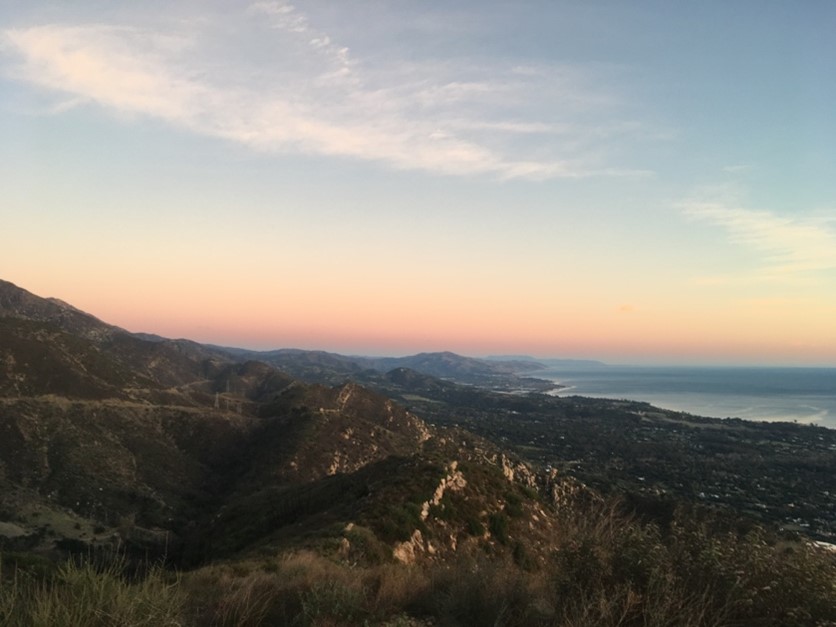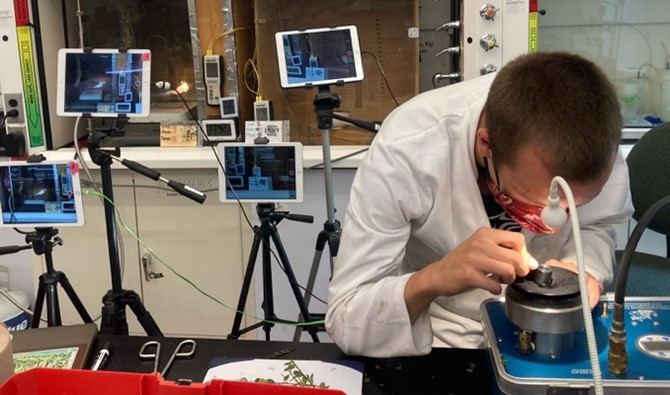In this revisited blog post, Indra Boving, a PhD candidate at University of California-Santa Barbara, USA, shares her work ‘Live fuel moisture and water potential exhibit differing relationships with leaf-level flammability thresholds’, which has been shortlisted for Functional Ecology’s 2023 Haldane Prize for early career researchers.
About the paper
Our paper was inspired by patterns observed across the landscape in Southern California chapparal: wildfires typically become larger and more frequent at distinct levels of plant hydration. These patterns guide fire severity warnings and risk indicators, such as the direction of Smokey Bear’s arrow when you drive into a forest. When Smokey’s sign shows a ‘high fire risk’, this means at least two things: plants are dry enough that fires are more likely to happen, and you probably shouldn’t be roasting marshmallows over them during your camping trip.

While the fact that drier plants are more flammable is fairly intuitive, our research aimed to determine if there was a relationship between live fuel moisture (LFM, the amount of water in plant tissue) and drought response in plants, and if patterns present at the plant level were similar to those observed on the landscape. To do this, we measured different flammability metrics (e.g. time to ignition, flame height, temperature) at different levels of LFM during both wet and dry seasons, and related measurements to plant water potential (a measure of plant drought stress) and to physiological adjustments that occur when a plant is experiencing drought (the turgor loss point). We found that increases in flammability occurred at levels of LFM similar to those present on the landscape level, and that these largely aligned with the turgor loss point.


Our findings point to mechanisms for landscape-level wildfire patterns that occur in individual plants, and provide a link between management-focused fire science and plant physiological studies. We hope this work can guide both management and policy by highlighting the importance of vegetation characteristics in wildfire dynamics, and the many important interactions between drought and wildfire that are likely to be exacerbated under climate change. To understand fire, we need to also understand the plants that act as fuel.
Fire, it turns out, is really hard to get to behave, even in very controlled settings. Most of the work for this paper revolved around getting our flammability chamber to work consistently. This included hours of troubleshooting, honing our carpentry and engineering skills, and testing different plant samples under different heating conditions—and then watching hours and hours of videos to measure various flammability metrics. Definitely the less glamorous side of ecology, but entirely worth it to see a story come together as the datapoints compiled.

Our next big questions involve studying flammability-physiology relationships in other species, especially in ways that might guide management in areas in where human populations are most at-risk for wildfire. Additionally, incorporating physiology into models of fire behavior is an exciting prospect, which I hope our work can inform.
About the author

Like most ecologists, I fell in love with science when I realized that it would allow me to both think about and be in beautiful natural places. I was a shy undergraduate when I started college, but Dr. Aaron Ramirez’s Leaf to Landscapes class at Reed College had me speaking up and asking questions more than I ever had before. I was enamored with the idea that small-scale processes in the tissue of plants might be used to better understand biogeography, and that these insights might help us better manage forests and mitigate against climate change. And, also, that I could spend many of my days hiking in forests and looking up at tree canopies.

Following my undergrad, I worked on this project in Max Moritz’s Fire Lab with my truly awesome co-authors (including both my undergraduate and graduate advisors!). Now, I am a PhD student with Dr. Leander Anderegg in the Landscape Ecophysiology and Function (LEAF) Lab at the University of California, Santa Barbara, where I am studying within-species trait variation to help guide management and climate mitigation in Sequoia National Park. In each of the labs I’ve worked in, I’ve found an environment that fosters collaboration, openness to new ideas, and mentorship (and humor!), which I hope to carry with me as I continue my PhD and beyond.
When not attempting to get leaf samples out of tall trees, I enjoy mountain biking, surfing the California coast, and doing pottery at our local community college.
